目录
一、5G/NR
1、 快速参考(Quick Reference)
2、5G Success
3、5G Challenges
4、Qualcomm Videos
二、PHY and Protocol
1、Frame Structure
2、Numerology
3、Waveform
4、Frequency Band
5、BWP
6、Synchronization
7、Beam Management
8、CSI Framework
9、Channel Mapping
10、CORESET
11、DCI
12、SLIV
13、UCI/PUCCH
14、Reference Signal
15、MAC
16、RLC
17、PDCP
18、SS Block
19、Scheduling
20、MIB / SIB
21、RACH
22、RRC Overview
23、RrcReconfiguration
24、NSA/ENDC
25、SA/Initial Attach
26、UE Capability
27、Paging
28、 Power Control
29、MIMO Config. DL
30、MIMO Config. UL
三、NAS / Core
1、Registration
2、Network Slice
3、Core Architecture
四、Misc.
1、Field Test
2、OTA(Over The Air)
3、Release 16
4、Release 17
5、Massive MIMO ?
6、WhyMassiveMIMO ?
7、Propagation Model
一、5G/NR
1、 快速参考(Quick Reference)
1) Pre 5G Chronicles
a、 What has been done/talked before the realization of 5G ?
b、 Time Table/Milestones
2) 4G to 5G Evolution**
3) 4G vs 5G
4) Post-deployment Evolution (Cell Coverage, Test Report)
5) Post-deployment Challenges
6) 5G Definitions
7) 5G Indication : upperLayerIndication
8) 5GMM
9) 5GSM
10)5QI
11) 5G Release 16 Highlights
12) 5G Release 17 Highlights
13) 5G Release 18 Highlights
14) 5WWC/ATSSS
15) Acronyms
16) Agreed Items
17) AI/ML (Aritificial Intelligence / Machine Learning)
18) AMF
19) Antenna Ports
20) Articles on 5G (Before Deployment)
21) ATSSS/5WWC
22) Beam Failure Recovery
23) Beam Forming
24) Beam Management
25) BWP(Bandwidth Part)
26) BWP Switching
27) Call Process : SA Initial Attach
28) Carrier Aggregation
29) Carrier Bandwidth Part (BWP)
30) Cell Search / SIB1 Decoding
31) Cell Selection
32) Cell Selection Criteria
33) CBG(Code Block Group)
34) Challenges
35) Channel Coding
36) Channel Structure / Channel Mapping
37) Common Search Space(Type 0 PDCCH, RMSI-PDCCH-Config)
38) Common Search Space(Type 1 PDCCH)
39) CoMP
40) ConfiguredScheduling/SPS
41) Converged Connectivity - ATSSS/5WWC
42) Core - Network Interfaces
43) Core - AMF
44) Core - NRF
45) Core - N22 - NSSF
46) Core - SMF
47) Core - UDM
48) Core - N1 Interface
49) Core - N26 Interface
50) Core - N12,N13 - AMF,AUSF,UDM - Authentication
51) Core - N8 - Registration
52) Core - NGAP
53) Core - SCTP
51) Core - GTP
52) CORESET(Parameters, Example)
53) CORESET 0/SIB 1 decoding
54) CPRI
55) CSI Framework
56) CSI Report
57) CSI RS
58) CSI RS Codebook
59) CU/DU Separation
60) Current Activities (Who is doing what ?)
61) DCI
62) Deployment Scenario
63) DFT-s-OFDM
64) DNN / LADN
65) Downlink Preamption
66) DSS (Dynamic Spectrum Sharing)
67) eCPRI
68) EIRP
69) Enhanced Massive MIMO
70) Event and Forum
71) Field Test
72) Frame Structure
73) Frame Structure : Candidate
74) Frequency Domain Position/Resource Block Indexing
75) FR(Frequency Range) / Operating Band
76) FRC (Fixed Reference Channel)
77) General News
78) GSCN
79) HARQ(ACK/NACK)
80) HARQ-ACK Codebook
81) History of 5G (5G before 3GPP)
a、 Activities
b、 Articles/New
c、 Propagation Model
82) IAB (Integraded Access / Backhaul)
83) IP Allocation
84) K0,K1,K2,N1,N2
85) LADN / DNN
86) LTE Interworking (NSA : Non StandAlone)
87) MAC : Overview
88) MAC CE
89) MAC CE : Buffer Status Report
90) MAC CE : C-RNTI
91) MAC CE : Contention Resolution
92) MAC CE : SCell Activation/Deactivation
93) MAC CE : TCI State Indication for UE-specific PDCCH MAC CE
94) MAC CE : TCI States Activation/Deactivation for UE-specific PDSCH MAC CE
95) MAC CE : Timing Advance
96) Massive MIMO : Introduction/Definition
97) Massive MIMO : Motivation (Why We Need it ?)
98) Massive MIMO : FD-MIMO
99) Massive MIMO : MU-MIMO
100) Massive MIMO : Channel Model
a、 Scaling up MIMO : Opportunities and Challenges with Very Large Arrays
b、 Massive MIMO and Small Cells : Improving Energy Efficiency by Optimal Soft-Cell Coordination
c、 Multi-Layer Precoding for Full-Dimensional Massive MIMO Systems
d、 MU-MIMO Channel Estimation
101) Massive MIMO : Reciever Model
102) Massive MIMO : in 3GPP
103) Massive MIMO : Technical Challenges/Further Studies
104) Matlab Toolbox : 5G Library : SS/PBCH Block
105) Matlab Toolbox : 5G Library : PDSCH/DMRS
106) Matlab Toolbox : 5G Library : PUCCH Format 0
107) Matlab Toolbox : 5G Library : PUCCH Format 1
108) Matlab Toolbox : 5G Library : Slot Structure : Downlink / All Channels
109) Matlab Toolbox : 5G Library : Slot Structure : Uplink
110) Matlab Toolbox : 5G Library : PRACH / FR2 (120 Khz)
111) Matlab Toolbox : 5G Library : SRS (120 Khz)
112) Matlab Toolbox : 5G Library : CSI-RS
113) Matlab Toolbox : 5G Library : CSI Codebook
114) Matlab Toolbox : 5G Library : Spectrogram : Downlink (SSB, PDCCH,PDSCH,CSI-RS)
115) Matlab Toolbox : 5G Library : NR Synchronization in TDL Channel
116) Matlab Toobox : 5G Library : NR Synchronization in CDL Channel
117) Max Throughput Estimation
118) MCS/TBS/Code Rate
119) Measurement
120) MIB / SIB
121) Mini Slot
122) MIMO : Downlink
123) MIMO : Uplink
124) mmWave
125) mmWave Antenna on UE
126) N1 mode / S1 mode
127) N1 Interface
128) N2 Interface
129) N8 Interface
130) N22 Interface
131) N26 Interface
132) NAS : 5GMM
133) NAS : 5GSM
134) NAS : Registration / Reject / Reject Cause
135) NAS : PDU Session Establishment
136) NAS : Service Setup
137) NAS : UAC (Unified Access Control)
138) Network Architecture / Network Interfaces
139) Network Architecture / Network Interface - N1
140) Network Slicing
141) New Waveform Cadidate : Introduction
142) New Waveform Candidate : FBMC
143) New Waveform Candidate : f-OFDM
144) New Waveform Candidate : GFDM
145) New Waveform Candidate : UFMC
146) New Waveform Candidate : DFT-s-OFDM
147) NGAP
148) NPN(Non-Public Network)
149) NRF
150) NR Indication : upperLayerIndication
151) NR-Light/RedCap
152) NRU (NR Unlicensed)
153) NTN (Non Terestrial Network)
154) Numerology
155) NWDAF
156) OpenRAN - Overview
157) OpenRAN - Architecture
158) OpenRAN - Where to Split
159) OSI (Other SI) Scheduling
160) OTA(Over The Air) Measurement
161) Paging
162) Parameter Structure : PHY
163) PBCH
164) PBCH DMRS
165) PBCH Decoding Process
166) PCO (Protocol Configuration Option)
167) PDCCH
168) PDCCH Common
169) PDSCH
170) PDSCH AggregationFactor
171) PDSCH DMRS
172) PDSCH PTRS
173) PDSCH/PUSCH Mapping Type (Type A, Type B)
174) PDCP
175) PDU Session Establishment (IP Allocation, QoS)
176) Physical Layer : Beam Management
177) Physical Layer : Frame Structure
178) Physical Layer : Numerology
179) Physical Layer : Pseudo Random Sequence
180) Physical Layer : Reference Signals
181) Physical Layer : SS Block, SS/PBCH
182) Physical Layer : Synchronization
183) Physical Layer : Timing Units
184) Physical Layer : Uplink Transmission Timing
185) Physical Layer : Waveform
186) Physical Layer Signal : PBCH DMRS
187) Physical Layer Signal : PDSCH DMRS
188) Physical Layer Signal : PSS (Primary Synchronization Signal)
189) Physical Layer Signal : SSS (Secondary Synchronization Signal)
190) Pyhsical Layer Channel : PBCH
191) Physical Layer Channel : PDCCH
192) Physical Layer Channel : PDSCH
193) Physical Layer Channel : PUCCH
194) Physical Layer Channel : PUSCH
195) PointA, OffsetToPointA
196) Positioning
197) Power Control
198) Power Definition / Measurement (RSRP, RSRQ, SINR)
199) Power Saving
200) Pre Trial : Overview
a、 Pre Trial : Frame Structure
b、 Pre Trial : Matlab : Frame Structure / Resource Element Mapping
c、 Pre Trial : Physical Signal : PSS
d、 Pre Trial : Physical Signal : SSS
e、 Pre Trial : Physical Signal : ESS
f、 Pre Trial : Physical Signal : BRS
g、 Pre Trial : Physical Signal : BRRS
h、 Pre Trial : Pseudo Random Sequence
i、 Pre Trial : Basic Procedure : Power On Procedure
j、 Pre Trial : RRC : MIB/SIB
k、 Pre Trial : RACH
201) Private Network (LTE)
202) Private Network/NPN(Non-Public Network) (NR)
203) Pseudo Random Sequence
204) Propagation Model
205) Protocol Configuration Option(PCO)
206) PSS (Primary Synchronization Signal)
207) PTRS - PDSCH
208) PUCCH
209) PUSCH AggregationFactor
210) PUSCH Channel Coding and Transmssion Process
211) PUSCH DMRS
212) PUSCH Precoding / Transmission Mode (Codebook vs Non-Codebook based)/UL Transmission Scheme
213) QCL (Quasi Co Location)/TCI
214) QoS / QFI / QRI
215) RACH
216) RACH-2 Step
217) Radio Protocol Architecture
218) RAN Architecture
219) RateMatchPattern
220) Reference Signal
221) RedCap/NR-Light
222) Registration - RegistrationRequest / RegistrationAccept
223) Release 16 Highlights
224) Release 17 Highlights
225) Release 18 Highlights
226) Resource Allocation (Time [K0,K1,K2])
227) Resource Allocation Type (RA Type 0, RA Type 1)
228) Resource Allocation Units (RE, REG, REG Bundle, CCE, Aggregation Level, CORESET)
229) Resource Allocation - Applicable Time Domain Resource Allocation
230) Resource Block Indexing/Frequency Domain Position
231) Resource Grid
232) RLC
233) RMSI-PDCCH-Config/Type 0 PDCCH Common Search Space
234) RNTI
235) RRC CONNECTED <-> INACTIVE Transition
236) RRC Constraints
237) RRC Overview
238) RRC INACTIVE
239) RRC Reconfiguration
240) SCG-Failure
241) Scheduling : Overview
242) Scheduling : Dynamic / L2 Scheduling
243) SDL (Supplimentary Downlink)
244) Security for 5G
245) Security for Cellular Ingeneral
246) Search Space
247) Self-Contained Slot
248) Service Setup
249) SIB 1 decoding
250) Sidelink
251) SLIV
252) Slot Configuration
253) Slot Format Combination
254) SMF
255) Software Defined Network (SDN) : Overview
256) Software Defined Network (SDN) : OpenFlow
257) Split Bearer
258) SPS/ConfiguredScheduling
259) SR(Scheduling Request)
260) SRB(Signaling Radio Bearer)
261) SRS/Antenna Switching
262) SS Block, SS/PBCH
263) SSS (Secondary Synchronization Signal)
264) SUL(Supplementary Uplink)
265) Synchronization
266) TBS Determination
267) TCI/QCL
268) TDD DL/UL Common Configuration(TDD-UL-DL-ConfigCommon)
269) TDD DL/UL Dedicated Configuration(TDD-UL-DL-ConfigDedicated)
270) Technical Challenges
271) Tech Viedos for 5G
272) Test : Equipment : Concept and Idea
273) Test : RF Connection Method
274) Throughput Estimation
275) Time Table (MileStones to 5G)
276) Timing Advance
277) Timing Units
278) TRS (Tracking Reference Signal)
279) Type 0 PDCCH Common Search Space/RMSI-PDCCH-Config
280) Type 1 PDCCH Common Search Space
281) Two Step RACH (2 step RACH)
282) UAC (Unified Access Control)
283) UCI (Uplink Control Information)
284) UDM
285) UE Assistance Information
286) UE Capability
287) UE ID
288) UL Transmission Scheme / PUSCH Precoding / Transmission Mode (Codebook vs Non-Codebook based)
289) URLLC
290) VoNR
291) Wake Up Signal(WUS)
292) Waveform
293) WhitePapers and Forums/Summits (Before 5G Deployment)
294) WUS (Wake Up Signal)
一、5G/NR
1、 快速参考(Quick Reference)
4) Post-deployment Evolution (Cell Coverage, Test Report)
● 5G演进(5G Evolution)
我将在本页中跟踪的并不是严格技术意义(strict technical sense)上的5G演进(如3GPP)。我在这个页面上试图做的是跟踪各种报告和文章(articles),以显示自2019年以来5G在首次部署(initial deployment)后是如何变得更好的(主要是)。在本页中,我打算(intend to do)重点介绍(highlight on)5G成功的方面。我还将重点关注各自challenges of 5G 。
● Coverage Map
▶ Worldwide (OOKLA)
▶ Worldwide (nperf)
▶ Worldwide(Cell Mapper)
▶ Worldwide (2019)
▶ Verizon (USA)
▶ AT&T (USA)
▶ T-Mobile (USA)
▶ South Korea (nperf)
▶ UK (nperf)
▶ China (nperf)
● Reports
▶ 5G transformation news bulletin: What’s the status of 5G globally? (Feb 2018, ABI Research - YouTube)
▶ The State of Wifi vs Mobile Network Experience as 5G Arrives (Nov 2018, OPENSiGNAL)
▶ 5G download speed is now faster than Wifi in seven leading 5G countries (May 2020, OPENSiGNAL)
▶ How AT&T, Sprint, T-Mobile and Verizon differ in their early 5G approach (Feb 2020, OPENSiGNAL)
▶ Survey: One Third of Mobile Operators Will Deploy 5G Standalone Within Two Years (Mar 2020)
▶ Radio Access Network Investments to Surpass $0.2 Trillion (Jul 2020)
▶ 5G smartphones reach 14% of U.S. sales as average price drops by 30% (Oct 2020)
▶ Mid-Year 5G 2020 Progress (Oct 2020)
▶ OpenSignal January 2021 5G User Report Summary (Jan 2021 - YouTube)
▶ Gartner Says Worldwide Smartphone Sales to Grow 11% in 2021 (Feb 2021)
● Emerging Use Cases
● Articles
▶ Want real 5G speeds? Get on Sprint or Verizon, report says (Mar 2020)
▶ Verizon sells 5G mmWave spectrum to GeoLinks (Mar 2021)
● Statistics
▶ Number of smartphones sold to end users worldwide from 2007 to 2021
▶ Number of wireless local area network (WLAN) connected devices worldwide from 2016 to 2021
● YouTube
▶ 5G mmWave: Disrupting or Disappointing? (Oct 2020)
▶ What can we learn from South Korea’s 5G success - Panel Discussion (Feb 2021)
5) 部署后的挑战(Post-deployment Challenges)
● 5G挑战(5G Challenges)
在这篇文章中,我将试图从技术和商业角度(perspective)跟踪5G面临的一些挑战。不是为了深入了解(deep-dive into)细节,只是为了跟踪各种挑战的高级描述。(注意:我也在跟踪5G在部署和应用(deployment and application)方面如何发展(evolve)的高层描述,在here的另一个注意事项中有一些积极的方面(a little bit of positive aspects))。
● 深深的分歧值得思考 (Things to think of)
以下是最近在我脑海中突然出现(pop)的5G挑战。我并不是想说“5G有很多问题/挑战,它最终(eventually)会失败”。我坚信科学和工程以及伟大的人类思想。我们最终会看到大多数挑战者都会被清除。我在这封信中试图做的是在我的脑海中以及在各种论坛/讨论(forums/discussions)中写下这些挑战,更重要的是展示这些挑战是如何得到解决(resolve)的。
▶ 是不是炒作过度了?(Is it over-hyped ? )
(2021年4月):在任何新技术中,都有一定程度的炒作(hype),我不认为这些炒作是故意的(intentional)或任何恶意(malignant intention)的。但通常过多的炒作会导致(result in)低谷(dip trough)。就我个人而言(Personally),我得到的印象(impression)是,与前几代相比,5G有一些炒作。大多数人都会记得(recall)那些说法(statement),比如“你可以在几秒钟内(甚至在几分之一秒内in a fraction of a second)下载巨大而高质量的电影”,“激光指示器(laser pointer)般的光束可以实时(in realtime)跟踪你的移动设备,无论你在哪里移动”,“你可以远程(remotely)控制无人机(drone)、汽车、工业机器人、医疗手术机器人(medical surgery robot),就像( as if)你自己动手(manipulate)一样”等等。至少目前,我认为这些说法(statement)并没有像许多人预期(expect)的那样得到实现(realize)。从技术上讲,这是不可理解的(understantable),因为5G仍处于早期阶段(at early phase),但对于许多公众(general public)来说,目前的状态(the current state)可能看起来有点令人失望(a little bit disappointing)。
▶ 毫米波性能是否如预期一样好?(Is mmWave performance as good as expected ?)
(2021年4月):你可能已经看到许多YouTubes在许多地方显示了接近2Gbps的吞吐量(throughput)。这些结果大多来自毫米波5G蜂窝。毫无疑问(Definately),这是一项惊人的(amazing)技术成就(technical achievement)。但你可能看过其他视频,抱怨(complain about)毫米波蜂窝(mmWave cells)连接(connectivity)的稳健性(robustness),比如当它们稍微( a little bit)改变手机的方向或位置,或者走在离蜂窝站(cell site)几百米远的街道上时,就会掉线call drop(或回到fall back to LTE)。似乎以期望的(desired )质量实现波束成形(beamforming)和波束管理(beam management)并不像预期的那么容易。
▶ 5G在室内的普及率是否足够?(Are we getting enough indoor penetration with 5G ?)
尽管有一些演示(demonstration)显示了室外gNB和室内接收器的良好性能(performance),但许多终端用户(end user)仍在抱怨(complain about)室内用户体验不佳。影响(affect)室内用户体验的因素(factor)有很多,比如墙壁、玻璃的材料和厚度,以及信号必须穿过多少堵墙才能到达设备等。根据射频常识,我们可以很容易地发现(figure out)5G/NR的室外到室内渗透( penetration)不如传统(legacy)技术。更不用说使用比传统技术高得多的频率的FR2,即使是常用的FR1频率(例如,高于3Ghz的FR1频带)也使用比传统频率更高的频率。这种较高的频率将是导致室内体验不佳的主要因素。我个人认为没有任何简单的技术解决方案(solution)。也许唯一的解决方案是使用室内小蜂窝。。。那么我们必须证明(justify)为什么我们应该在有低成本/易于设置的WiFi解决方案的情况下使用室内小蜂窝。
▶ 有什么杀手级的应用程序吗?(Is there any killer APP ?)
(2021年4月):在4G之前,我认为已经有一些杀手级的应用程序从部署(deployment)的早期就得到了很好的认可(recognize)和接受(accepte),但我还没有看到任何有吸引力的(appealing)5G应用程序application(或商业模式)。为什么?有很多用例声称(claim)是5G杀手级应用程序(例如,VR/AR、远程控制Remote Control、V2X、物联网IoT等),但我认为这些用例还没有吸引到人们。是因为5G技术不够成熟(mature),无法实现(implement)用例,还是这些用例本身没有预期的那么有吸引力(attractive)?
▶ 售出的设备数量和部署的运营商是否表明接受5G?(Does the number of sold devices and the deployed carrier indicate the acceptance of 5G ?)
(2021年4月):各种类型的报告或新闻稿( press release)数字显示了有多少运营商(carrier)部署(deploy)了5G,有多少5G手机正在推出(roll out),试图暗示(hint)5G正在被市场广泛接受,5G业务很快就会蓬勃发展(blossom)。事实真的会是这样吗?我认为这个数字本身是真的,但这并不一定意味着这些数字与5G在市场上的接受程度(acceptance)直接相关(be associated with)。几乎每一个网络运营商(network operator)都想表明他们并没有落后于这一趋势(trend)。5G手机购买者中有很大一部分(Large portions of)只是被动(passive)购买者。他们只是想买最新的高端( high end)手机,而所有的高端手机恰好(happened to)都支持5G。
▶ 5G核心网络部署速度够快吗?(Is 5G Core Network Deployment fast enough ?)
(2021年4月):5G做出的许多承诺(promise)不仅要通过无线电接入网(RAN:Radio Access Network)来实现,还需要在端到端的(end-to-end)所有数据路径上进行创新(innovation)。从各种报告和统计数据(statistic)中,我们可以看到RAN的部署(deploy)速度有多快,但我们没有看到类似的(similar)报告/统计数据显示5G核心网络(5G CN:Core Network)和其他后端(backend)数据路径的进展。我认为在没有5G CN的情况下部署5G RAN的技术解决方案solution(即NSA:Non-Stand Alone/非独立)是一个好主意,这可能是显示5G服务提供速度如此惊人的(amazing)一个非常重要的因素(factor),但这将是减缓(slow down)5G核心网络部署(deployment)的一个因素。许多运营商(carrier)设法声称(claim),他们的网络只需RAN投资(investment)就可以实现5G,然后他们会进一步等待,直到他们对5G商业模式更有信心(confident),而无需对5G核心部署进行太多投资。
▶ 对于内容或应用程序服务提供商来说是很好的商业机会,但对于运营商来说就不那么有利可图了?(Good business opportunities for contents or application service provider, but not so lucrative for carriers ?)
(2021年4月):对于每一个新的许可频谱(licensed spectrum),运营商(carrier)都必须为拍卖(auction)投入大量资金(invest a lot)。对于每一项新技术(如3G、4G、5G等),他们都必须在部署(deployment )和维护(maintenance)方面投入大量资金。似乎一些网络运营商开始思考“所有这些投资(investment)会给我们带来足够的回报吗?或者我们只是在用大量投资铺平道路(pave the road),但所有的司机都在路上行驶,而不支付通行费(pay toll)。看,我们建立(set up)了移动网络的所有基础设施(infra structure),但现在大多数语音通话(voice call)、视频通话(video call)和短消息几乎是由其他人免费(for free)提供的。这种情况在5G中不会重演吗?”。你可能会说“运营商仍然对数据服务收费(charge )很高”,但运营商可能会有不同的意见。
▶ 为什么3GPP如此复杂? (Why 3GPP is so complex ?)
(2021年4月):5G承诺了许多可能不是蜂窝通信(cellular communication)领域的应用application(如工业自动化industrial automation、V2X等)。为了扩大(expand)5G运用场景(playground),该技术应该让那些不太熟悉3GPP的工程师适应(accommodate)3GPP世界。但老实说(to be honest),对于许多优秀但不熟悉3GPP的工程师来说,3GPP看起来势不可挡(overwhelming)。对于许多应用来说,这可能是一个巨大的实际(practical )和心理(psychological)障碍(barrier)。它应该以如此复杂的(complicated)方式设计吗?你确定没有更简单的方法吗?
▶ 5G能战胜WiFi吗?(Can 5G win over WiFi ?)
(2021年4月):我个人以前没有想过这么多。我只是觉得蜂窝(Cellular)和WiFi有自己的优势(advantage),没有太大的竞争(compete)。在某些方面,它仍然成立。但随着蜂窝技术试图扩展其应用,WiFi也在尝试同样的事情,我想我看到两者之间的竞争(competition)越来越激烈,尤其是当WiFi 6推出(came out)了许多曾经是蜂窝系统的强项的功能,而WiFi 7将在几年后准备就绪,声称我将达到be amount to(甚至在某些方面超过surpass)5G的独特功能(capability)时。那么,考虑到成本、易用性、易部署性等,5G如何证明(justify)使用5G而不是(instead of)WiFi是合理的呢?根据(According to)这一统计数据(statistic),最近一年,智能手机的年销售额约为15亿部,无线网络连接设备的年销售额超过200亿部。
注1:您可以参考ABI Research在《5 Beyond The Consumer Market》中总结的另一份5G挑战清单。
▶ YouTube
5G Technology Challenges (Jan 2017)
mmWave Measurement Challenges for 5G (Jun 2017)
Challenges in mmWave Wireless Channel Measurement and Analysis (Jun 2017)
The challenges of deploying 5G (Jun 2017)
What are the challenges of deploying 5G? (Jan 2019)
Overcoming deployment challenges in 5G networks (Nov 2019)
5G explained | Challenges for 5G network | English | Sarvesh Kannan #5g (Sep 2020)
5G mmWave: Disrupting or Disappointing? (Oct 2020)
Industrial 5G: Remaining challenges and future perspectives (Nov 2020)
Media and beyond 5G: Opportunities and Challenges (Nov 2020)
5G and Next G Innovation Opportunities and Challenges (Apr 2021)
A Journey with mmWave research (Apr 2021)
▶ 3GPP Reference
6) 5G Definitions
● What is 5 G ?
“我不知道-:)。”是我在2013年年中第一次写这篇文章时对这个问题的回答,直到2016年年中,答案才改变。从2016年底开始,许多事情开始在3GPP中发生,现在(2017年3月)我们得到了几个TR(38.801、38.802、38.803、38.804),这些TR描述了将在正式的(formal)NR(5G)规范中指定(specify)的技术要求的细节,这意味着现在我们非常详细地知道了5G(NR)会是什么样子。
如果你想立即获得正式的3GPP定义,只需跳到(jump to)正式(3GPP)定义,但我也会保留所有其他定义,以防你有兴趣追踪多个主要参与者的愿景,以及这些愿景是如何整合到(be consolidated into)正式定义(需求)中的。
到目前为止,任何标准组织(standard organization)都没有正式定义5G。然而,有几个组织描述了关键技术组成部分或关键性能指标(KPI:key performance indicator),这些组织可能会设想(envision)5G会是什么样子。我会列出几个不同组织的功能列表。
▶ Initial Definition
▶ Formal (3GPP) Definition
▶ Build Up Intuition on 5G
▶ Definition by METIS
▶ Definition by 5GNOW
▶ Definition by SKT
▶ Definition by 4G America
▶ Definition by NTT DOCOMO
● 初始定义 (Initial Definition)
当第一次谈论5G时,一些原型测试(prototyping test)结果出来了,重点(focus)主要是吞吐量。(直到2013年年中,这种关注点才发生太大变化)
至少,有一件事是肯定的,那就是数据速率(data rate)将至少达到几个G bps。(4G数据速率的最终目标(final goal)是1GHz,要实现(achieve)1Gb的速率,我们还有很长的路要走)。
到目前为止(截至2015年11月),你可能会看到几十份关于5G的白皮书。如果你通读(read through)了所有这些白皮书,你会注意到它们在文档中声称(claim)的关键概念几乎相同。就我个人而言,我建议(recommend)您通读METIS的文件。我认为METIS文件是迄今为止(by far)最广泛、最深入的(the most extensive and most in-depth)。唯一的问题是这些文件太厚了:)
以下是我个人阅读这些论文中关于5G的一些关键词。
| Keywords | Description |
|---|---|
| Extremly High Data Rate | By far, we don’t know yet (as of Nov 2015) what would be the maximum throughput. But I think it will be targeted to be at least around 10 Gbps. |
| Extremly Low Data Rate | Just achieving the extermly low throughput has no technical problem. But critical technological issue is that achieving the extremely low data rate with extremly low cost and extremely low energy (battery) consumption. Refer to MTC criteria for the details. |
| Extremly Low Latency | We don’t know yet (as of Nov 2015) what would be the target latency. But by far, around 1 ms latency are the most commonly mentioned number. (In terms of subframe length, it would be around 100us or 200 us) |
| Super High Frequency | The words ‘High Frequency’ or ‘Low Frequency’ can be misleading because it would be a relative concept, but I say ‘Super High Frequency’ comparing to current cellular communication frequency (mostly under 3 Ghz). By far (as of Nov 2015), the most frequently commented frequenty blocks are 6 Ghz, 15 Ghz, 20~30Ghz and the highest frequency being tried is a little bit over 70 Ghz. |
| Super Wide Bandwidth | The words ‘Wide Bandwidth’ or ‘Narrow Bandwidth’ can be misleading because it would be a relative concept, but I say ‘Super Wide Bandwidth’ comparing to current cellular communication bandwidth (100 MHz, ideal max in 4G). The most commonly mentioned bandwidths are 160 Mhz, 400 Mhz, 800 Mhz. Currently the widest bandwidth being mentioned are 2 Ghz bandwidth. |
| Softwares as much as possible | Many components in core network would be software based and with this it would become very flexible and accomdate news features in short time frame |
● 正式(3GPP)定义(Formal (3GPP) Definition)
最近Recently(截至as of 2016年6月),RAN召开了几次会议,主要关注5G,并定义(define)了几个官方(official)技术术语(term)。
首先要定义的是“整个5G技术的名称是什么?”。正如我们将4G称为LTE一样,5G也必须有类似的名称。它是什么?至少目前,5G的官方名称是NR,代表(stand for)新无线电(New Radio)。(我已经看到很多人说NR不是一个合适的名字,因为5G不仅仅指(refer to)无线电技术(Radio Technology)。但无论如何,目前NR是官方术语(official term)。
那么NR的官方定义是什么呢?由于LTE没有单线官方定义,因此NR也没有单线正式定义。但在我个人的定义中,我想说‘NR是从物理层(Physical layer)到核心网络(Core Network)的技术集合(collection),需要实现(achieve)以下三个主要功能(要求),如下图所示。图中所示的术语也是正式的(formal)3GPP术语,您将在NR3GPP的大多数文档中看到这些术语。因此,熟悉(get familiar with)这些术语对您来说是件好事。
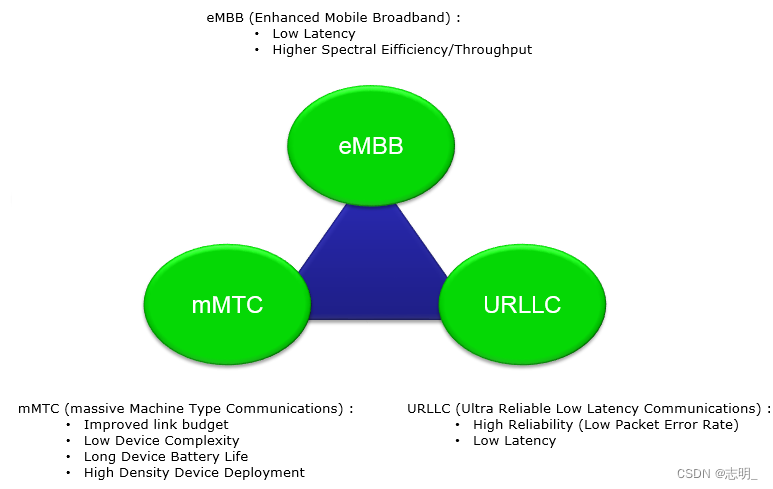
● Build up Intuition on 5G
在你阅读之前,只需欣赏(enjoy)这些视频片段(video clip),让你的大脑建立(build up)自己的直觉intuition(洞察力Insight)。B
▶ World’s first 5G mobile ‘device’
▶ Millimeter Wave Technology for 5G
● METIS定义(Definition by METIS)
2013年8月提出(propose)的METIS可以做出更具组织性和形式化的(organized and formal)定义。尽管METIS没有提出明确的(explicit)“定义(definition)”,但它提出(propose)了几个KPI(关键绩效指标Key Performance Indicator)。我认为我们可以说“满足(satisfy)METIS KPI的通信系统可以归类为(be categorized as)5G”。
以下是执行(perform)METIS提出的KPI测量的KIP和测试用例(test case)列表。(详见D1.1 and D2.1 METIS document)
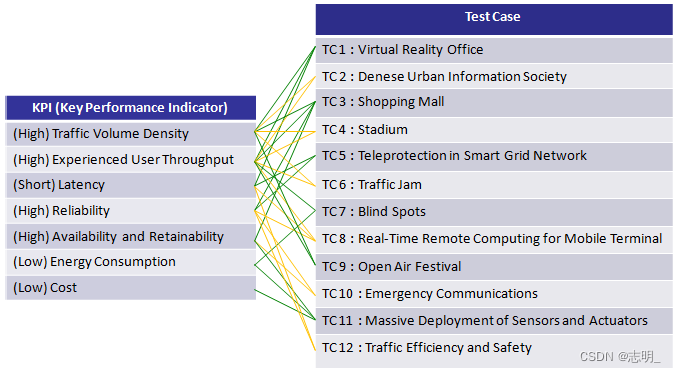
METIS为实现5G目标而提出的技术要求为:
▶ 典型用户数据速率(data rate)高10-100倍,其中在密集的(dense)城市(urban)环境中,典型用户数据率的范围从1Gbit/s到10Gbit/s;
▶ 每个区域per area(每个用户)的移动数据增加1000倍,其中每个区域(每用户)的容量(volume)将超过100 Gbps/km2;
▶ 支持连接的设备增加10-100倍;
▶ 低功率大规模(massive)机器通信的电池寿命延长10倍,其中传感器(sensors)或寻呼机(pager)等机器的电池寿命为10年(decade);
▶ 支持超快的(ultra-fast)应用程序响应时间,端到端(end-to-end)延迟(latency)小于5ms,可靠性(reliability)高;
▶ 在与当今蜂窝系统类似的成本和单位面积能量耗散(energy dissipation)的情况下满足(fulfil)这些要求的能力。
● 5GNOW定义( Definition by 5GNOW)
5GNOW并没有对5G的高级别定义或使用模式进行太多描述(decribe)。我想任何5G高级定义都属于(fall into)METIS定义/使用模型的范围(scope)。5GNOW将更多地讨论5G的低级别实现(impelmentation)。5GNOW讨论/提出(propose)的关键实施项目(implementation Item)如下。

在我阅读了5GNOW Deliverable文档的大部分内容后,我脑海中不断(consitantly)弹出(pop-up)的关键词是
▶ 异步(Asynchronous)
▶ 突发性低数据速率传输(Bursty low data rate transmission)
▶ 增强型PRACH(Enhanced PRACH)
自己思考为什么会出现这些问题(issue),然后参考5GNOW可交付文件。
● SKT定义(Definition by SKT)
以下来自SKT(韩国SK电信SK Telecom, South Korea)发布的白皮书(SKT WhitePaper)
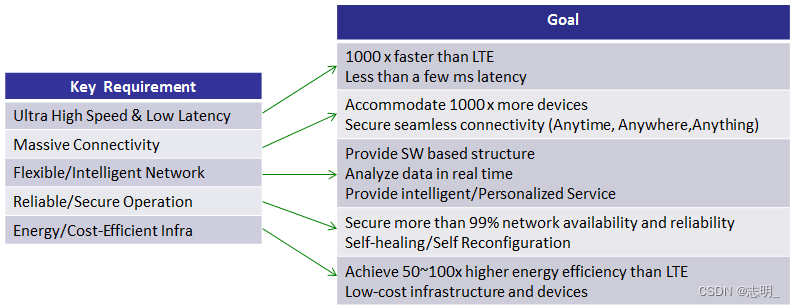
下表也来自SKT白皮书。老实说(To be honest),我不确定这些项目(item)中有多少最终(eventually)会被行业标准所采用(adopt),但我认为,如果你想对未来通信的特定(specific)技术进行更详细的研究,这可以是一个很好的起点清单。我建议(recommend)你阅读几次原始(original)白皮书,并搜索相关(related)文档(例如,每个项目的相关(Related)论文(Paper)和论文(Thesis))
▶. Realistic(真实的) UX and 5G Contents Process
▷ Object/space Recognition(识别): Fast Recognition of surrounding objects and spaces by a camera or sensors
▷ Real Time(实时) Rendering(渲染) and Display: Display(Rendering) of an object in realtime recognized(识别) by glass or HMD
▷ Real Time Hologram Processing(全息处理): Reconstructing(重建) a real image of an object with 360 degree field of view in 3D space
▶. Efficient Processing & Transmission(传输) of Tactile Multimedia(触觉多媒体)
▷ MMT(MPEG Media Transport) : a special MPEG technology to minimize(减少) latency(延迟) in media transmission in All-IP network
▷ High Efficiency Multimedia Coding(多媒体编码): Multimedia Coding Technique for efficient creation/transmission of realistic(逼真的) 3D multimeidia contents (e.g, MVC : Multi-view Video Encoding)
▷ Cloud-based Computing, Caching and Orchastration: Dynamic Allocation and Orchestration of cloud resource and caching to process realistic high volume multimedia
▶. Cloud-based All-IP Network and Service Platform
▷ NFV-based Virtualied Core Network Operation Techniques to build the cloud by virtualizing a standard hardware and operate a range of networ/service functions on the software-based network.
▷ Virtualized RAN Techniques to centralize and virtualize DU(Digital Unit) of a base station into a standard HW based cloud and process RAN signals in real time.
▷ SDN and integrated Orchestraion Effective control and lifecycle management of the software-based network services from a centralized & unified network service orchestrator
▶. Analytics-based Network Intelligence & Optimization
▷ Big Data Analysis Techniques to process, analyze and infer large volume of multi-dimensional/unstructured data
▷ Network Intelligence & Analysis Techniques to optimize operation and performance of networks from information on performance, log, traffic
▷ Analytics-based SON Techniques to automatically detect abnormality, to optimize and take necessary measures
▶. Fast, Flexible Transport Network
▷ POTN (Packet Optical Transport Network) All-IP/All-Optical transport technology that converges multiple layers to increase simplicity and efficiency of network
▷ Transport SDN Integrated Networking technology to efficiently use and automatically control network resources in multi-layer, multi-vendor, multi-domain networking environment
▶. Beyond-Cellular Network Architecture
▷ Direct D2D Communication Techniques to directly share information and data between devices
▷ Contents Centric Networking (CCN) A network architecture that stores content in a transport equipment on the network path and provides it by a mapped name of content
▶. Enhanced Operation for Multi-cell/HetNet
▷ Elastic Cell Techniques to dynamically select and communicate with a cell best for the user’s current channel environment in real time
▷ Aggregation of Heterogeneous Networks Techniques to improve data rate by combining cellular networ with different networks such as WiFi or with unlicensed LTE band
▶. Ultra-Dense Small Cell
▷ Dynamic interference control and coordination Techniques to improve signal Quality at cell edges by enabling nearby cells to cooperate in real time
▷ HetNet SON Techniques to automatically optimize wireless network operation in diverse cell environment to improve QoS
▶. Wideband High Frequency RF & 3D BeamForming
▷ 3D BeamForming Techniques that provies RF environment for high-speed transmission by controlling electromagnetic waves or forming multiple beams in the vertical and horizontal directions
▷ Beam Switching/Tracking Techniques that provides an optimal link by selecting an optimal beam out of many or changing the direction of the antenna beam according to the location of the user.
▶. Enhancement of Multiple Antenna Technology including Massive MIMO
▷ UE-Specific Beamforming Techniques that suppresses mutual interference between multiple terminals by utilizing independent and sharp beams
▷ CSI/CQI Feedback Techniques that enhances accuracy of CSI and CQI while minimizing uplink signaling overhead
▶. Advanced IoT & New Waveform/Duplex
▷ Cellular-based MTC (Machine Type Comm) High Capacity multiple access & machine data processing technology to support IoT service on mobile communication network
▷ New Waveform (NOMA, FBMC) Transmit and receive technology that increases efficiency of accommodating multiple users and data through reciever interference cancellation and filter-based interference supporession
▷ Hybrid duplex & Full Duplex Communication Flexible allocation scheme for DL/UL resources and simultaneous transmit and receive technology based on self - interference cancellation
● 4G美国定义(Definition by 4G America)
本节(section)内容基于(be based on)白皮书:4G Americas’ Recommendations on 5G Requirements and Solutions。
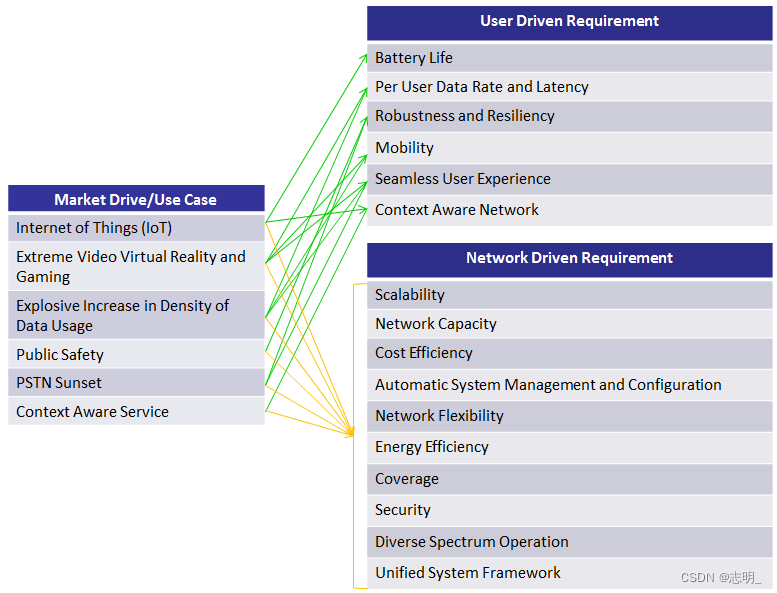
● Definition By NTT DoCoMo
本节内容基于白皮书: 5G Radio Access: Requirements, Concept and Technologies - DOCOMO 5G White Paper
▶ <5G的技术趋势和动机(Trends in Technology and Motivation for 5G) >
| 这一趋势(trend)目前主要表现(represent)为M2M、MTC、IoT。事实上,每一种组件技术都已经可用(available),并被各个领域所采用(adopt),但它们还没有在大范围内集成(integrate)。我们需要一个灵活的(flexible)蜂窝网络(cellular network),能够集成所有这些不同的(diverse)组件,5G将为此发挥关键作用(playing a crucial role)。 | 这些都是新兴(emerging)技术,意味着相对(relatively)较新的技术,但每个组件的开发/实现(development/implementation)已经采用(adopt)了一段时间。但这并不是蜂窝通信的目标(target ),因为所需的数据速率太高了。为了将这些应用程序连接到蜂窝网络,我们需要一种支持极高数据速率的新蜂窝技术。这种极高的数据速率将是5G的关键特征之一。 |
|---|
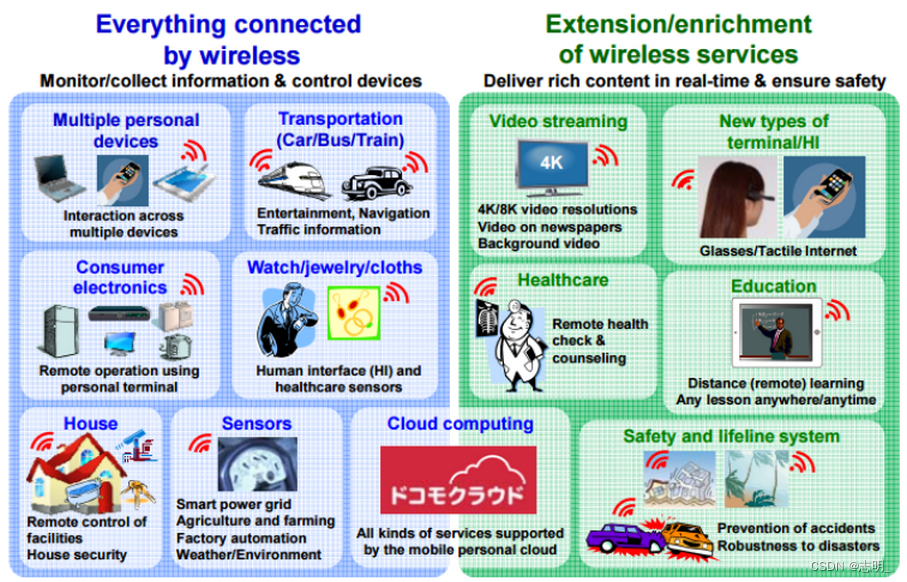
▶ < Key Requirement >
